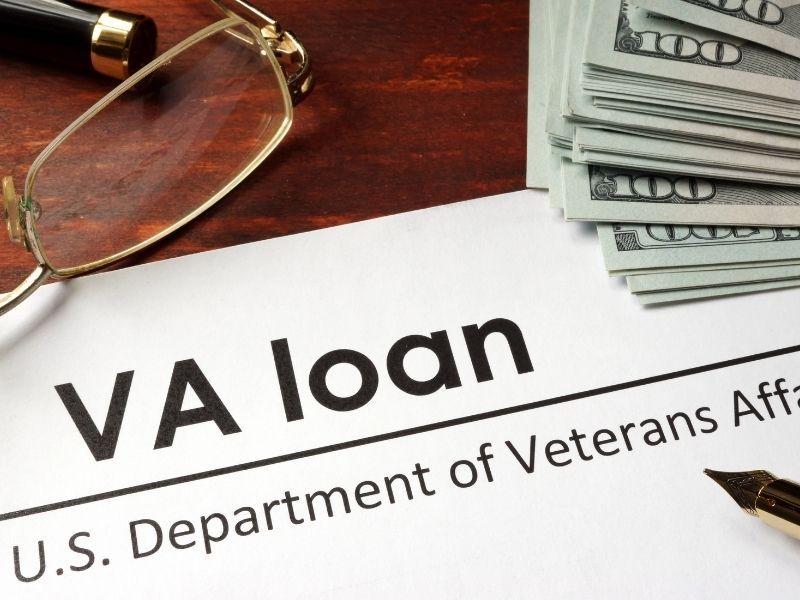How to Use Your VA Loan to Build Lasting Wealth
If you’re a veteran or active service member, you’ve probably heard about the benefits of a VA mortgage home loan. After all, it offers a range of exclusive perks (which we’ll discuss shortly) designed to lower the barrier of entry to homeownership and help veterans and their families settle into the home of their dreams.
However, what few people know is that VA loans can also be used to build wealth through real estate.
While VA loans can’t be used to buy property that is solely meant for investment—like a tenant-occupied property or an immediate flip-and-sell home—there are ways to use a VA loan to generate not only long-term appreciation but also additional monthly income.
Here’s how it’s possible to use your VA loan to build lasting wealth for you and your family.
What Is a VA Loan?
VA loans are home mortgage loans backed by the U.S. Department of Veterans Affairs and offered to service members in exchange for service to their country.
Not only do these types of loans help to make the lending process a little more cut and dry for military members, but they also offer a ton of unique perks to borrowers who qualify, including a $0 down payment option that can help to remove the typical high cost of entry that comes with buying a property.
However, to access these benefits, you must be an active military member, veteran, or eligible surviving spouse. So if you don’t meet the requirements, you can’t take advantage of what these loans have to offer.
To explain these unique benefits available to veterans, What’s My Payment interviewed Nelvia Bullock, who works with potential home buyers as a Realtor and the Director of Diversity at Costello Real Estate and Investments.
“The borrower/veteran is able to obtain 100% financing,” she notes. “There are no money down requirements, and you also avoid paying PMI (which is private mortgage insurance).”
Another key benefit, she adds, is that “credit qualifications tend to be more lenient, and depending on the circumstances this loan type offers other complimentary prepaid items like pest control inspections and appraisals.”
All of these perks mean that veterans have a distinct advantage to becoming homeowners over other borrowers.
VA Funding Fee
While VA loans tend to offer unique benefits that can help you afford a property more easily, there is one additional cost you’ll need to factor in with a VA loan.
It’s called the VA funding fee, and it is essentially an insurance premium paid to the VA to guarantee 25% of the loan balance. If you make a higher down payment, you’ll pay a lower VA funding fee. If you buy a home with a VA loan and put $0 down, you’ll pay a higher funding fee. The good news is, though, that the fee can be rolled into your mortgage loan premiums, and it’s typically less costly than other types of mortgage insurance.
(You can find a more detailed breakdown of how to calculate your funding fee here.)
Requirements for Buying Real Estate with a VA Loan
VA loans have helped many veterans and their families open the door to homeownership.
However, what many fail to realize is that VA loans can also be used to purchase a multi-family residence, allowing you to build not only long-term appreciation but also recurring income.
There is a catch, though. To use your VA loan to purchase any property, you must meet the following requirements:
1. You Must Be Eligible for a VA Loan.
As noted, VA loans are limited to active military members, veterans, and eligible surviving spouses, so you’ll need to prove that you’re eligible before you can take out a VA loan. You can find everything you need to prove your eligibility and apply for your Certificate of Eligibility (COE) right on the VA.gov website.
If you are currently on active duty and have been for 90 continuous days, you are generally eligible for VA loan benefits, as are veterans who were honorably discharged, though veteran benefits are dependent on the dates you served.
In nearly all cases, military members who were discharged due to service-connected disability will be eligible, no matter how much time they served.
2. You Must Live on the Property.
This is the biggest hurdle to using your VA loan for purchasing an investment property.
If you apply for a VA loan, you have to buy a property that you’re planning to live in, at least in some form or fashion. That could be a single-family home or a property with a couple of homes on it—but you must live in one of the units to qualify for the loan.
“A VA loan can only be used for a primary residence in which the veteran intends on living in the home; otherwise, it would be mortgage fraud,” Bullock warns.
3. The Property Cannot Contain More Than Four Single-Family Units.
While VA loans are primarily geared toward single-family homes, there are exceptions that allow you to buy a property with multiple homes on the property. As noted, though, you must live in one of the units if you do so, and there can’t be more than four single-family units on the property.

What this rule means is that duplexes, triplexes, and quad-plexes are all fair game for a VA loan purchase, but you can’t use your VA loan to buy a large apartment building.
And, there’s more good news for investors who qualify for VA loans and are interested in multi-unit properties. Your rental income from the other units can count as income to help you qualify for the loan. To do this, you'll need to have enough cash on hand to cover at least six months worth of mortgage payments. You’ll also need to show that you have documented experience as a landlord.
If you can meet those qualifications—and if you can collect 75% of the rent that was charged on the property before you bought it or if you can collect 75% of the rent an appraiser projects you can make — you can use that projected income to help qualify for your loan.
How Real Estate Builds Wealth
Using a VA loan to purchase an investment property is a great way to help build wealth. That’s because real estate in general helps to generate wealth in a few different ways.
Appreciation
Property appreciation is one of the easiest ways to accumulate wealth via real estate. Let’s say, for example, that you purchase a home that’s worth $100,000 in 2020. The home has an annual appreciation rate of 4%, which amounts to about $4,000 per year. In 2020, just 10 years time, you’ve accumulated about $40,000 more in appreciation on the home.
You can use that wealth to borrow against, and it’s also wealth you’ll earn when you sell the home.
Rental Income
Now, let’s say you purchase a duplex with your VA loan and your monthly mortgage payment is $800. The going rate for rent in your neighborhood for a 2 bedroom, 2 bathroom unit is $650. The money your tenant pays you, $650 each month, goes toward the majority of your mortgage payment.
The other income you earn can be saved, invested, or used to purchase other investment properties to continue building your wealth.
Equity
You also build wealth through equity when you own real estate. With each mortgage payment you make, some of the money goes toward interest, and some of the money goes toward your principal to pay down your loan. The more you pay off the principal, the more of your house you truly own.
You can borrow against your equity or leverage it in other ways, and most importantly, it’s there when you sell your home as the cash difference between what you owe and what the buyer paid for your home.
When asked how that leveraging process works, Bullock explains, “The primary benefit of leveraging real estate to build wealth is having the ability to use your home as a line of credit to fund other investments, home improvements and/or cash out refinances. It's beneficial to have these types of lending options because the rates are much lower and more competitive than other types of credit.”
The Risks of Real Estate Investment
Real estate investing isn’t all reward and no risk, mind you. While there are benefits to investing in real estate, there are also some potential downsides to consider.
Unknown Housing Market Fluctuations
When you own property, you’re at the mercy of the housing market in terms of appreciation. You may buy in a neighborhood with great appreciation rates, but if something changes, your appreciation rate could go downhill or you could lose some of the value of your home.
Time Commitment
Any seasoned landlord will tell you that one of the toughest parts of owning investment property is finding a good tenant. Not all tenants will pan out, and if you have to evict a tenant or constantly track your tenant down for the rent, you’re going to spend a lot of time doing so.
And, tenants aren’t always the issue. There could be other interpersonal problems outside of your control that you’re stuck dealing with, like issues with a neighboring property or problems with parking spots. You never know what issues will pop up as a landlord, so be prepared to spend some time resolving them.
Inconsistent Income
Tenants will move out eventually, and when they do, you may have a tough time finding a new one. That means you’ll be losing money on the empty unit every day that it goes unoccupied.
Not to mention, things break, and when they do, it will be your responsibility to fix them. A broken dishwasher or a leaky pipe could turn into a major repair—so be prepared for the unexpected.
Plus, no matter how well you vet potential tenants, there’s always the possibility that they will cause damage to the property. Maybe you have to evict a non-paying tenant, and they destroy your property. Or maybe you rent to someone who appears to be a great tenant, but they end up secretly taking in a stray puppy that isn’t house-trained.
While you may be able to recover the cost of damages from a security deposit, these types of issues can be much more costly than they seem up front and contribute to more and more damage over time.
Is Real Estate Investment Worth It?
With all that said, do these downsides outweigh the benefits of owning an investment property? Probably not.
There are risks with any investment, but investing in real estate does offer both income and long-term appreciation—which can make destructive tenants or vacancies worth the hassle for the right landlord.

Kit Lockett, a real estate agent with Maxwell Realty LLC, has bought and sold over 20 of her own properties and knows the potential downsides that come with real estate investing. “With every investment there are risks,” Lockett warns. “While the risks are lower in real estate, the losses can be greater.”
However, she also notes this could be a matter of playing the waiting game: “Real estate typically appreciates, so in most cases, it's not a matter of if you will receive a return, it is more a question of when.”
To avoid making a costly mistake, Lockett recommends that “new investors need to educate themselves on the risk. The market can crash and shift. Investors can overvalue a property's market position and be stuck with a home that will not sell.”
It’s important, she emphasizes, to “always plan for the worst case scenario and have an exit strategy.”
5 Steps to Building Wealth with Your VA Loan

By now, you should have a better idea of what your VA loan can—and can’t—do for you when it comes to buying an investment property. It’s true that as a VA loan recipient, you’ll need to jump through some additional hoops in order to be approved.
Buying a property with the goal of building wealth requires careful planning, especially with the added requirements of applying for a VA loan. However, with just a few extra steps, you can find a property that works as both a home for your family and a lucrative investment.
1. Assess Your Finances
Proper planning is the key to success. That’s why the first step you need to take is to make sure that you are financially ready for a VA loan.
Our VA loan calculator will give you an accurate view of your future monthly VA mortgage loan payments by accounting for the appropriate VA funding fee, down payment, property taxes, and homeowner's insurance.
This will help you to get a better idea of what properties you can actually afford given your budget.
The VA will also assess your finances to ensure that you meet certain debt-to-income and residual income requirements to qualify for a loan. Keep in mind that these qualifications are different from conventional mortgage loan qualifications.
DTI Ratio
Your debt-to-income (DTI) for a conventional mortgage is calculated by finding the sum of your monthly debt payments, including credit cards, loans, and mortgage. Once you have that number, you divide your total monthly debt payment amount by your monthly gross income. This gives you a decimal number, which you multiply by 100 to achieve your DTI percentage.
For a VA loan, on the other hand, a 40% debt-to-income is advised, but the number isn’t set in stone.
Residual Income
VA underwriters use loan analysis form 26-6393 to compute your residual income, which is what’s left after the other expenses that traditional DTI doesn’t include are calculated in.
Your residual income will give you a better idea of what you can afford each month for a mortgage payment because it addresses real dollars and not a percentage, but it can be tricker to qualify for a mortgage with a lower income.
So, you may want to do the math before your Certificate of Eligibility arrives to make sure you’re meeting the income requirements for the property you’re considering according to the VA formula—not the conventional formula for DTI.
2. Calculate Your Expected Cash Flow
You should also estimate your potential cash flow to get an idea of the types of property to look for. Unfortunately, figuring out how much cash flow will come from different investments isn’t as simple as Rent - Mortgage = Cash Flow. Realistically, there are other factors that will need to be accounted for.
Your cash flow will depend on your plans for your ideal property. You can start by considering how many units your ideal property would have and how you would use them. For example, you may decide to rent out a spare room or an English basement. On the other hand, you may want to purchase a property with up to 4 separate single-family units.
Once you have a general idea of what you’re looking for in a property, you’ll need to do some research into the rental rates based on your area. If you know what the going rate is for the types of units you want to invest in, you can figure out what the average income is from those rentals.
From there, you can make an educated guess for the cash flow you can expect from various properties. To do this, you should:
- Subtract mortgage, insurance, taxes, and expenses from the rent prices for your unit.
- Your recurring expenses typically include things like lawn care and common area cleaning or management fees.
- Then, subtract 15-20% to account for unpredictability, like emergency maintenance and vacancy, from the total.
- You may want to keep a tenant in your rental year-round, but it’s unrealistic to assume 100% occupancy, 100% of the time.
- The number that is left over, minus the expenses and the unpredictability costs, will be the expected cash flow.
- If you’re looking at the right properties, it should be positive.
- If you’re looking at the wrong types of properties, you’ll see that reflected in a negative number, which is what it would cost you out of your own pocket to rent your space out each month.
3. Find a Property with Space to Lease
Now comes the fun part: finding the right property with the right spaces to rent out. This may be easier said than done, though.
If you’re using a VA loan, you’ll also need to live on the property, so in addition to being a promising investment property, it will need to suit your standards, too. Part of making sure that your property will suit your needs is already baked into the VA loan process in the form of the VA appraisal requirements.
VA Appraisal Requirements
One trickier part of using a VA loan is the appraisal requirements. The VA requires its own appraisals for any properties that are purchased by using a VA loan. As part of the lending process, the government will send a VA-approved appraiser to estimate the house’s value and ensure that the property is safe and ready for move-in, and this step is where many deals fall through.
The properties you buy with a VA loan must meet the minimum property requirements, or the loan application will be denied. There are multiple minimum property requirements that must be met, and any one of them could cause your loan to be denied.
These requirements include:
- Residential: The property must be a residential property to qualify.
- Electricity: It must have safe and working electrical systems.
- Wiring: There cannot be exposed wiring, which is a safety hazard, on the property.
- Heating and cooling systems: The heating and cooling systems must be working properly throughout the home.
- Roofing: The roofing must not leak or have other problems.
- Pests: Pest damage can kill a VA loan deal, too.
- Water and sanitation: The VA appraiser will also ensure there is a safe water supply, hot water, sanitary facilities, and safe sewage disposal.
- Mold: Mold issues are also a significant issue for the VA appraisers.
- Drainage: Adequate drainage is also key.
- Accessibility: If you can’t access the property during certain times of the year, the VA appraiser can’t approve your loan.
- Lead-based paint: Lead-based paint is a hazard that the VA appraisers can’t overlook.
- Enough space: This one is open to interpretation, but the VA appraiser must confirm that there’s adequate space within the home to meet the needs of the buyer.
- Access: If you can’t access the crawl space or the attic, it could be problematic.
Considerations for Buying an Investment Property
VA appraisals shouldn’t be the only deal-breaker for properties, though. You should also make sure that you consider what it takes to have a good investment property.
To start, you’ll want to weigh the geographical location of the property. That doesn’t just refer to curb appeal, either. You’ll also want to evaluate the school district it’s zoned to, the crime rates, whether it has access to public transportation, and the distance to local amenities. All of these factors are important to tenants, and if you want to make your investment work for your money, you need to study the market.
The best properties attract the best tenants, so make sure the properties you’re considering offer everything a tenant could want.
You’ll also want to weigh the home’s potential (along with how hard you’re willing to work to bring it out).
Is the property you’re considering a bit of a fixer-upper? That’s OK—but only if you’re willing to put in the work. If you’re ready to use some elbow grease to spruce up a property in need of some TLC, you can build home equity early on in the process and increase the amount that potential tenants are willing to pay in rent—but only if it’s in the right area and if the bones are good.
Just be sure to balance your own wants with the needs you have for an investment property and the property’s potential. All three factors will make an impact on whether you’re making the right move for your investment purchase.
4. Make Your Final Decision
Once you’ve put in the legwork to find your dream property, it’s important to avoid getting caught up in the moment.
Step back, take off your rose-colored glasses, and do your homework. You’ll need to figure out how much your property is actually worth and measure it against how much you’ll need to charge in rent to pay off the mortgage.
The 1% Rule
The 1% rule helps you to determine if the monthly rent on an investment property will exceed that property's monthly mortgage payment. You want to at least break even on your investment each month, and ideally, you will exceed it.
To determine whether your property fits the 1% rule, you simply multiply the purchase price of the property—as well as any necessary repairs—by 1%. The result of that equation tells you your baseline for your monthly rent.
Once you have that number, you can compare it to your monthly mortgage payment. This will give you a clear idea of the property’s potential cash flow—and whether you’ll break even or exceed the monthly mortgage payment via your tenant’s rent payment.
Now, hold on to that number as you determine how much your property is actually worth.
Real Estate Valuation
In order to calculate that valuation on your potential property, you can use a number of methods.
Start with the sales comparison approach, which compares similar homes to the one you’re considering that have rented locally over a given time period. Make sure you’re looking at properties that offer similar features, bedrooms and bathrooms, garages, driveways, pools, or anything else that makes the property noteworthy.
Then, take into account the square footage. If similar properties are renting for about $1 a square foot (or $2, or $3, or $4), you can expect a similar return on your property.
Multiply that per square foot number with square footage of your property and compare it against the sum from your 1% rule calculations. That will tell you whether your rental income makes the home purchase a wise purchase for your money.
You can use other valuation equations, too. Take, for example, the capital asset pricing model (CAPM), which is a more comprehensive valuation tool that factors in things like risk and opportunity cost. This model suggests that you weigh whether any potential negatives—high crime or location issues—will cut down on the amount of monthly rent you can ask for.
5. Maximize Your Return on Investment
Finally, once the ink is dry on your new property deed, you should also be sure to make the most of your investment whenever possible.
Doing so can lead to higher cash flow—and more money you can put aside for the future.
Here are just a few ways to maximize your investment over time:
Raise rent with inflation and market demand.
If you’re in a hot area that just keeps getting hotter, don’t drag your feet on raising the rent. Your tenants should expect to pay a market rate for their rent, and you should expect to charge them that. As rental rates go up in your area, so do the prices on your properties. That’s how market demand works—especially in areas with low vacancies.
Renovate and improve the property.
Properties with nice fixtures and amenities demand higher prices for a reason. Invest into your properties whenever you can. This could mean bathroom upgrades, kitchen renovations, stainless steel appliances, or nice landscaping. New paint can make a huge difference, too (and it won’t cost you much out of pocket to do it).
The goal is to attract good tenants who recognize and respect the value of the property, so any time you can afford to improve your property, you may want to consider doing so. It will help keep you competitive and attract the right types of tenants.
Minimize tenant turnover.
Every time a tenant moves, it costs you more in time and money for advertising, showings, and cleaning (not to mention the opportunity cost of leaving your unit unoccupied).
Make sure you’re meeting the needs of your tenants and getting repairs done quickly when necessary. If you have a high tenant turnover, you’re going to have high losses with your profits, so do what you can to keep your tenants sticking around and paying rent. Your wallet will thank you.
Use your VA loan benefits to continue building your investment portfolio.
Did you pay off your existing property and VA loan? If so, you may want to consider using the remaining VA benefits offered to you to obtain another investment property. You’ll have to move to meet the residency requirement of your loan, but that’s a small price to pay for more investment property and revenue generation.
Stay in your home for at least 3 years.
As noted above, VA loans are a lifetime benefit. However, Bullock advises that you should “plan on being in your home for 3+ years if you intend on selling your home after using a VA loan to ensure that you have established some decent equity.”
Put Your VA Benefits to Work for Your Future
Your VA loan benefits can do more than just put a roof over your family’s head.
They’re also a great way to get your foot in the door of real estate investment by taking advantage of low interest rates and low down payment requirements. Without these high barriers to purchasing property, veterans and their families have a path to building wealth that is not available to the general public.
That’s why, if you qualify for this type of loan, you may want to consider whether an investment property is right for you.
By taking this route, you’ll be able to build wealth in a myriad of ways. You’ll gain equity, benefit from appreciation, and may even be able to get a good cash flow going via your tenant’s rent. It takes some time—and some leg work—to pull it off, but the benefits typically far outweigh any disadvantages if you take this route to real estate investment.










